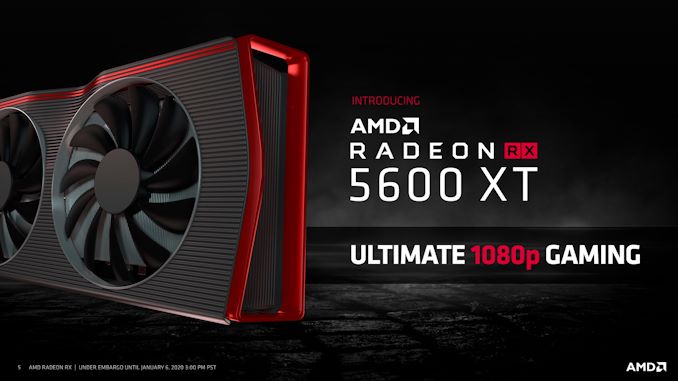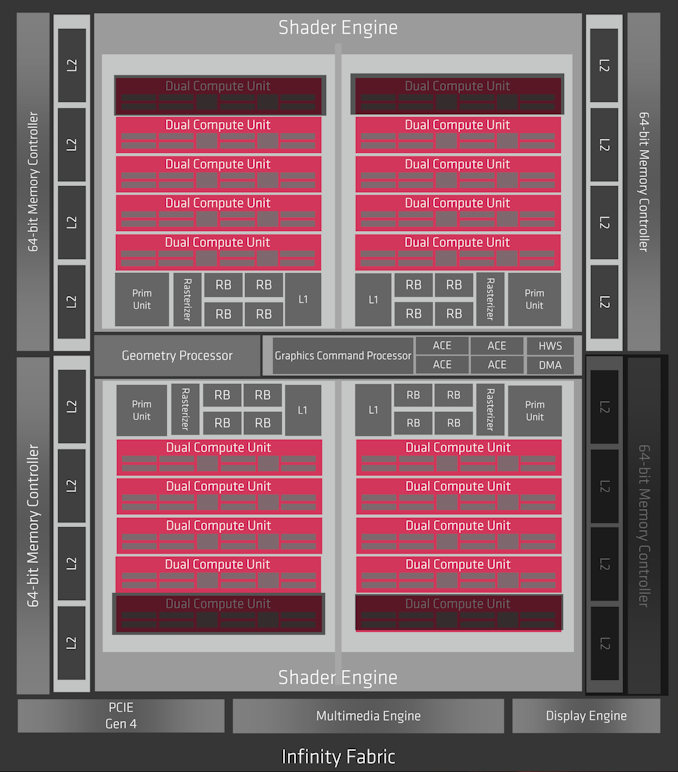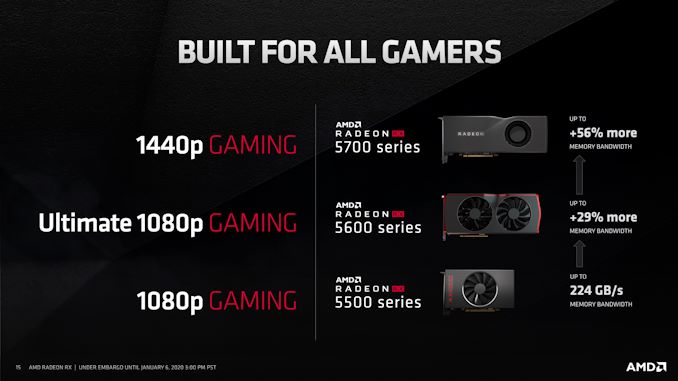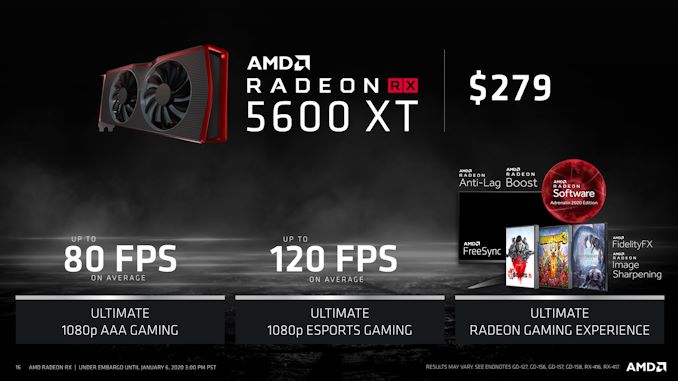AMD Announces Radeon RX 5600 Series: A Lighter Navi To Rule 1080p Gaming
by Ryan Smith on January 6, 2020 5:46 PM EST
With the launch of the Radeon RX 5700 series and Radeon RX 5500 XT under their collective belt, AMD is now getting ready to fill in the divide between the card families. With the RX 5500 XT carrying a $199 price tag and the next step up being the $349 RX 5700, there’s a significant gap in price and performance between the two cards. All of which has left AMD at a disadvantage in the popular $200-$300 mainstream segment, where NVIDIA’s GeForce GTX 1660 cards dominate. To that end, today AMD is announcing the third sub-series of the Radeon RX 5000 family, the Radeon RX 5600 series. These latest cards will be coming to retail, OEM, and mobile, with the retail Radeon RX 5600 XT leading the charge.
Designed to fill that gap between the RX 5700 series and the RX 5500 series, the $279 RX 5600 XT is employing a further cut-down version of AMD’s class-leading Navi 10 GPU. For their latest card, AMD is dialing back on the amount of enabled hardware in order to offer a card with performance between the existing Radeon RX 5000 series cards, and with a price to match. The net result is a card that, in AMD's words, is intended to be the ultimate 1080p gaming card, and just as importantly, go head-to-head with NVIDIA’s GeForce GTX 1660 cards.
| AMD Radeon RX Series Specification Comparison | ||||||
| AMD Radeon RX 5600 XT | AMD Radeon RX 5700 | AMD Radeon RX 5500 XT | AMD Radeon RX 590 | |||
| CUs | 36 (2304 SPs) |
36 (2304 SPs) |
22 (1408 SPs) |
36 (2304 SPs) |
||
| Texture Units | 144 | 144 | 88 | 144 | ||
| ROPs | 64 | 64 | 32 | 32 | ||
| Base Clock | 1235MHz? | 1465MHz | 1607MHz | 1469MHz | ||
| Game Clock | 1375MHz | 1625MHz | 1717MHz | N/A | ||
| Boost Clock | 1560MHz | 1725MHz | 1845MHz | 1545MHz | ||
| Throughput (FP32) | 7.2 TFLOPs | 7.95 TFLOPs | 5.2 TFLOPs | 7.1 TFLOPs | ||
| Memory Clock | 12 Gbps GDDR6 | 14 Gbps GDDR6 | 14 Gbps GDDR6 | 8 Gbps GDDR5 | ||
| Memory Bus Width | 192-bit | 256-bit | 128-bit | 256-bit | ||
| VRAM | 6GB | 8GB | 4GB/8GB | 8GB | ||
| Transistor Count | 10.3B | 10.3B | 6.4B | 5.7B | ||
| Typical Board Power | 150W | 180W | 130W | 225W | ||
| Manufacturing Process | TSMC 7nm | TSMC 7nm | TSMC 7nm | GloFo/Samsung 12nm | ||
| Architecture | RDNA (1) | RDNA (1) | RDNA (1) | GCN 4 | ||
| GPU | Navi 10 | Navi 10 | Navi 14 | Polaris 30 | ||
| Launch Date | 01/21/2020 | 07/07/2019 | 12/12/2019 | 11/15/2018 | ||
| Launch Price | $279 | $349 | $199/$169 | $279 | ||
As mentioned earlier, AMD hasn’t minted a new GPU for the Radeon RX 5600 XT. Instead, the company is using a further cut-down version of Navi 10, which is already used for the Radeon 5700 series. And while AMD generally avoids talking about salvaging when discussing lower-tier products, it's difficult to imagine that's not a factor here, even if the official line is focused more on it being a conscientious choice to bring Navi 10 down to compete with NVIDIA's GTX 1660 series. Either way, with the RX 5600 XT essentially getting a third-tier Navi 10-based card.
All told, it is rather rare for AMD to offer a third-tier part on the desktop; normally the company only offers two cards/configurations before moving up or down to the next GPU. Part of their current situation is based out of sheer necessity on the GPU side of matters – Navi 14 isn't powerful enough for the market AMD is chasing – though I imagine yields on the 7nm process also have room to improve since it's still relatively young. At the end of the day, it means AMD can kill two birds with one stone by putting chips that would otherwise be discarded to use in a card to counter the GeForce GTX 1660 series.
Digging into the specifications, as it’s configured, the Radeon RX 5600 XT is set to be firmly between the RX 5700 and RX 5500 XT in performance. AMD’s interesting choice of functional blocks to cut (and not to cut) means that the RX 5600 XT actually retains a lot of the RX 5700’s "core" GPU performance: on paper, the card's shading, texturing, pixel throughput, and compute performance are all quite close to the RX 5700, with the only difference is 15% lower average clockspeeds. AMD has even retained Navi 10's 64 ROPs, meaning that the card has plenty of pixel pushing power.
Instead, the big tradeoff in specing out the RX 5600 XT has been in memory bandwidth, and to a lesser extent memory capacity. The RX 5600 XT ships with 6GB of GDDR6 on a 192-bit memory bus, which is to say that 1/4 of Navi 10's MC/L2 partitions have been disabled. Furthermore the card ships with 12Gbps GDDR6 instead of the 14Gbps chips found on the RX 5700/5500. As a result, the RX 5600 XT has 36% less memory bandwidth than the RX 5700, coming in at 288GB/sec, making this the biggest factor differentiating the RX 5600 XT from its RX 5700 sibling.
The flip side of the coin, however, is that a 192-bit memory bus means that the RX 5600 XT has a lot more memory bandwidth than the RX 5500 XT, with the new card delivering 29% more memory bandwidth here. And with significantly more ROPs and CUs to feed than the RX 5500 XT, the RX 5600 XT is posed to shoot well past AMD's cheaper 1080p card.
Cutting back on memory bandwidth makes a lot of sense for AMD, both in terms of differentiating products with regards to performance as well as bringing down the card’s manufacturing price. That said, this is the first time in a long while that we’ve seen an AMD card with a 192-bit memory bus; the company normally just doesn’t do it. Power-of-two configurations are easier to deal with for various reasons, and it’s always allowed AMD to pack in more memory than NVIDIA’s competing mid-range cards. Ultimately the use of a 192-bit bus means that AMD can put to work Navi 10 GPUs with a bad memory controller, all the while using fewer (and cheaper) memory chips than in a 256-bit card. But it also means they are only able to outfit the card with 6GB of memory, as opposed to 8GB.
Without getting entirely sidetracked here, I went into this matter a bit back in the RX 5500 XT launch, but I do have some concerns about cards with less than 8GB of VRAM. With the next-gen consoles set to launch this year, the bar on hardware requirements is about to be significantly raised in one fell swoop, and I worry that sub-8GB cards won’t have enough memory capacity. With all of that said, however, whatever the ramifications are, it will mean AMD and NVIDIA are on equal footing: both the RX 5600 XT and GTX 1660 series ship with 6GB of VRAM, so both cards will thrive or falter at the same time. Clearly explaining a 6GB RX 5600 XT versus an 8GB RX 5500 XT is going to be a trickier matter for AMD's marketing department, however.
Rounding out the hardware package, AMD tells us that the new cards will ship with a TBP of 150 watts, which like everything else is right between the RX 5700 and RX 5500 XT. The smaller VRAM amount and lower clockspeeds help to bring down power consumption versus the RX 5700, which helps to keep AMD's energy efficiency up. In fact, AMD tells us that their 150W TBP value for the retail card is a bit on the conservative side of matters, and that real-world power usage will sometimes be less, so I’ll be interested in seeing just what our benchmarks turn up in a couple of weeks for the new card.
Product Positioning & The Competition
Since the RX 5600 XT is built from the same Navi 10 GPU as AMD’s RX 5700 cards, AMD’s board partners will be hitting the ground running here in terms of board designs. Some will just outright be reusing RX 5700 designs, while others will be tweaking their designs to account for the narrower memory bus, lower TBP, and lower sticker price.
This also means that this is a board partner-driven launch. AMD doesn’t have a (public) reference card, and it is the board partners shipping custom designs from day 1. As these are sub-$300 cards we won’t be seeing anything too exotic – mostly the usual variations on two and three fan designs – though factory overclocked cards will be peppered into the mix.
As mentioned previously, AMD’s target market for the RX 5600 XT is mainstream gamers, with the company offering a card that is supposed to be the final word in 1080p gaming. 1080p is still the single largest segment of the gaming market, and after watching rival NVIDIA sell GTX 1060 cards by the millions over the last few years, it's a market that AMD isn't content to leave alone.
Within AMD’s product stack, the RX 5600 XT doesn’t have a particularly good direct predecessor. The closest analog would be the Radeon RX 580 or RX 590, which is somewhat the same lineup that the RX 5700 served to replace. However as it’s not as powerful as the RX 5700, the RX 5600 XT, there's an argument to be had about whether it can deliver a full generational performance update over the RX 580/590. Though as an upgrade to older RX 300-era systems it would be a gigantic step up, or as a natural step within AMD’s expanding product stack for new system builds.
The competition for the RX 5600 XT then is both NVIDIA’s GeForce GTX 1660 series and their older GTX 1060 cards. AMD is especially keen on winning over GTX 1060 owners who are looking for an upgrade, but aren't satisfied with NVIDIA's offerings. None of the Turing cards have been true generational upgrades over their Pascal predecessors, so this is a sentiment that AMD is hoping to build off of by offering a better 1080p card than NVIDIA.
And with a cut-down Navi 10 part, AMD should be able to get there. While all vendor numbers should be taken with a large grain of salt, AMD's internal benchmarks have them ahead of the entire GTX 1660 family, and given the RX 5600 XT's specs (and what RX 5700 can do), this is fairly believable. In fact the biggest challenge for AMD isn't even raw performance, but rather it's beating NVIDIA on overall value.
While NVIDIA’s recent mid-generation Super refresh has kind of made a mess of their product stack here, the $229 GTX 1660 Super has become a clear front-runner of the GTX 1660 family, as its great perf-per-dollar ratio has made the other GTX 1660 cards (e.g. GTX 1660 Ti) rather redundant. So although AMD can handily beat the entire GTX 1660 series on performance, it's not the $279 GTX 1660 Ti where AMD's stiffest competition lies. Instead, they need to be able to convince potential buyers that iRX 5600 XT is worth the $50 premium over the competitively priced GTX 1660 Super.
Overall, AMD is rolling out the Radeon RX 5600 XT with high hopes. The company has a clear goal in mind: to dethrone NVIDIA at the high-end of 1080p, and they have hardware that should be able to do it. Now we'll just have to see where the cards come to rest when the Radeon RX 5600 XT launches on January 21th. So stay tuned for our full look at AMD’s latest video card later this month.
| Q1 2020 GPU Pricing Comparison | |||||
| AMD | Price | NVIDIA | |||
| Radeon RX 5700 | $329 | GeForce RTX 2060 | |||
| Radeon RX 5600 XT | $279 | GeForce GTX 1660 Ti | |||
| $229 | GeForce GTX 1660 Super | ||||
| Radeon RX 5500 XT 8GB | $199/$209 | GeForce GTX 1660 | |||
| Radeon RX 5500 XT 4GB | $169/$159 | GeForce GTX 1650 Super | |||
| $149 | GeForce GTX 1650 | ||||






















83 Comments
View All Comments
Kangal - Wednesday, January 8, 2020 - link
Maybe not.The price will likely be dropped slightly or remain the same, but the performance is expected to increase substantially. This means "performance:price" factor will go up, ie, better value for consumers. I don't expect many improvements on the architecture, it will mostly come from the lithography improvements, but they'll definitely be tweaking their Extra Cores (Ray-Tracing, NPU, etc).
Here's why the price won't be a factor:
History! AMD really dropped the ball with the RX 480 launch, which initially wasn't competitive (enough) against the GTX 1060. They were floundering since the launch of the R9 290, so there was big expectations which they could not fulfil. And since then the Vega cards and Polaris refresh have really hurt them and the industry. The Radeon division was basically saved by the cryptocurrency boom from a few years ago. Yet, it gave Nvidia basically several generations of cards with practically no competition. And Nvidia was wise to capitalise on that opportunity by sidelining AMD from the race by using "Ray Tracing" to differentiate themselves. Of course this was a risk, and it didn't entirely pan out.
Despite that, the gamble Nvidia took didn't really hurt them. However, they did suffer lower revenue and profits since the release of RTX cards. So they slightly came back to value with the "Super Turing" variants. Honestly, I think this is where Nvidia will stay since testing the market. And their only reason to reduce pricing would be competition. The only reason for increasing price would be Time and Inflation.
Firstly, I don't think Intel is going to make anything substantial in the GPU market. It's a tough market and they aren't prepared for it. And they're too pre-occupied doing damage control on their reputation, and trying to fix their fab process.
Secondly, I don't think AMD will do "Proper Ray Tracing" soon. At best they'll nearly catch up to the RTX 2060, and at worst Nvidia will actually mature their technology in both hardware and software, and have it out in actual games, and ALL their cards will support it.
Thirdly, AMD is now always behind in hardware and software, compared to Nvidia. Sometimes it is a little, but sometimes it is by a lot. It all comes down to Nvidia having more workers and better workers, basically flexing their R&D division. AMD cannot match them yet, but they will catch up in two years time, as their success from Ryzen and Consoles pay dividends. So we can expect Navi+ to be mostly a dud, but their follow-up (or the one after) should actually be a substantial improvement even if it's not too impressive on a 5nm lithography. They'll do it by sheer increased R&D and development into software and architecture. Not sure what they'll call it: Alpha, Taurus, Orion, Sirius, Antares, Rigel, Canopus....? But I've no doubt it's coming, this isn't the ancient Radeon company, nor is it the olde AMD company, this is the new "Lisa Su" AMD company.
Korguz - Wednesday, January 8, 2020 - link
Kangal for the most part.. nvidia priced them selves out of reach for most people with the 20 series cards.. most of the people i know.. wont even look at those cards cause of the prices.. they cant justify the prices compared to what they have.. to what they would need to spend.. and.. paying their bills.. feeding their families is more important.. but the common thing seems to be.. i dont have any games that support ray tracing or will be getting any that do.. so.. ill skip this round.. for me.. my strix 1060 is fine for what i play.. so unless nvidia drops their prices or amd releases something that is as fast for less.. meh...Spunjji - Tuesday, January 7, 2020 - link
I'm genuinely excited (from a tech perspective) to see what Nvidia do at 7nm.I'm also painfully aware that it'll be entirely theoretical for me, as Nvidia haven't given a rat's ass about value for money since Maxwell. As a result, I'm still running a GTX 980M...
maroon1 - Tuesday, January 7, 2020 - link
my old laptop has 970M and the new one is RTX 2060 (not QMAX)Day and night difference between the two
I don't now know how much upgrade you get from 980M, but from 970M and lower, Turing is huge upgrade
sing_electric - Tuesday, January 7, 2020 - link
Even if they did, chances are overwhelming it'll be PCIe 4.0 - same as the 5500 - so if/when you get a compatible platform, it'll have the same bandwidth as a x16 PCIe 3.0 slot. (Though I doubt they'd do that - the 5600 looks different enough from the 5700 that I don't think they need to be OVERLY worried about people stepping back.)Spunjji - Tuesday, January 7, 2020 - link
The RX 5500 isn't "gimped" by that interface. You'd get no more performance from more lanes.TheinsanegamerN - Tuesday, January 7, 2020 - link
Ahem.https://www.neowin.net/news/pcie-30-could-be-cripp...
oin bandwidth heavy games, that x8 interface makes a very big differnece. The 5500 line is gimped on non AMD platforms.
Korguz - Thursday, January 9, 2020 - link
um.... try non pcie 4 platforms...PVG - Tuesday, January 7, 2020 - link
How well does the 12Gbps GDDR6 overclock?If it can reach ~14Gbps easily enough, this card can become a little monster...
neblogai - Tuesday, January 7, 2020 - link
Probably depends on the VRAM chips, but for nVidia cards like the 1660S- I've seen memory to overclock that much and more, and not be limited to 12Gbps.